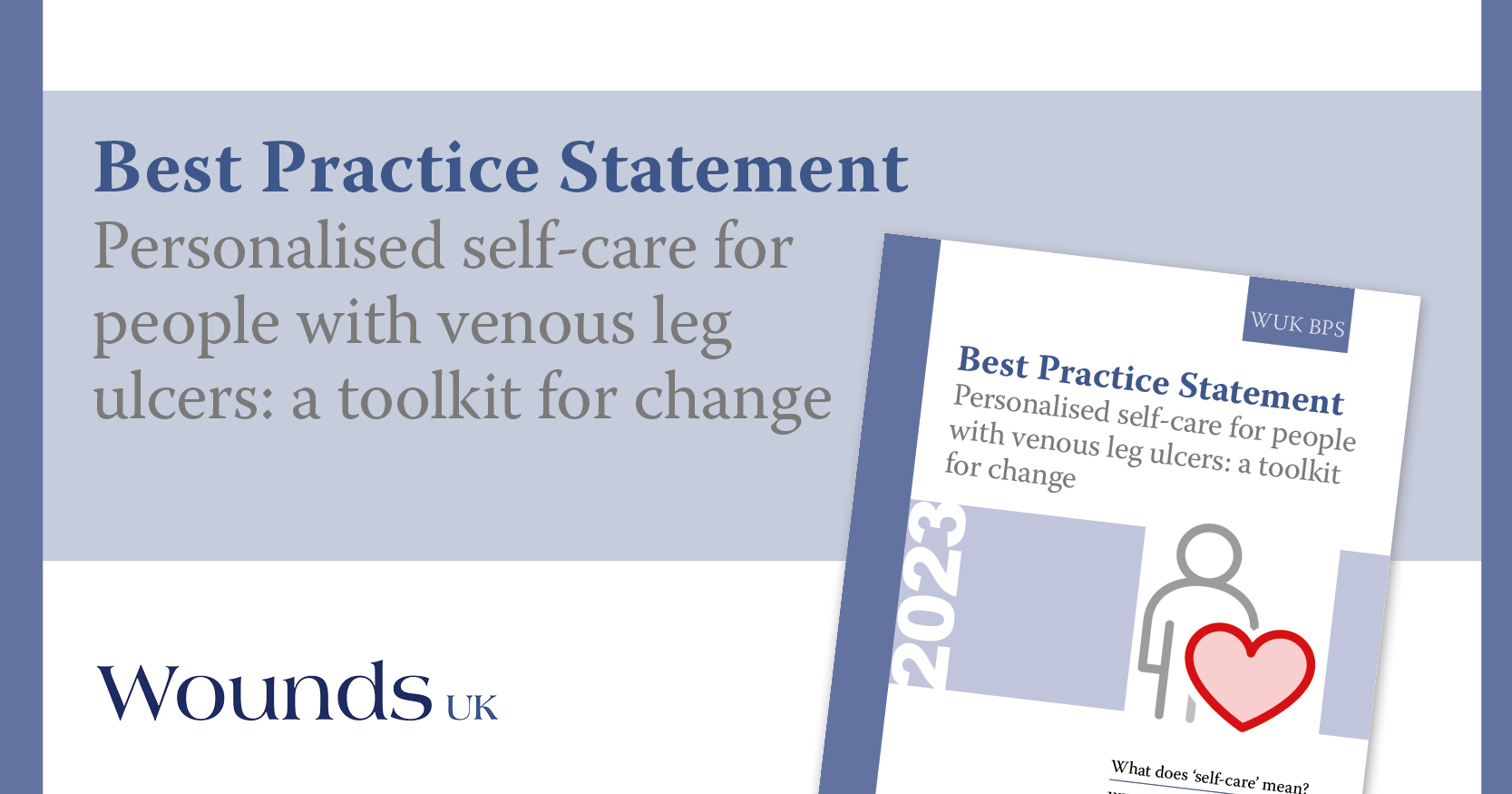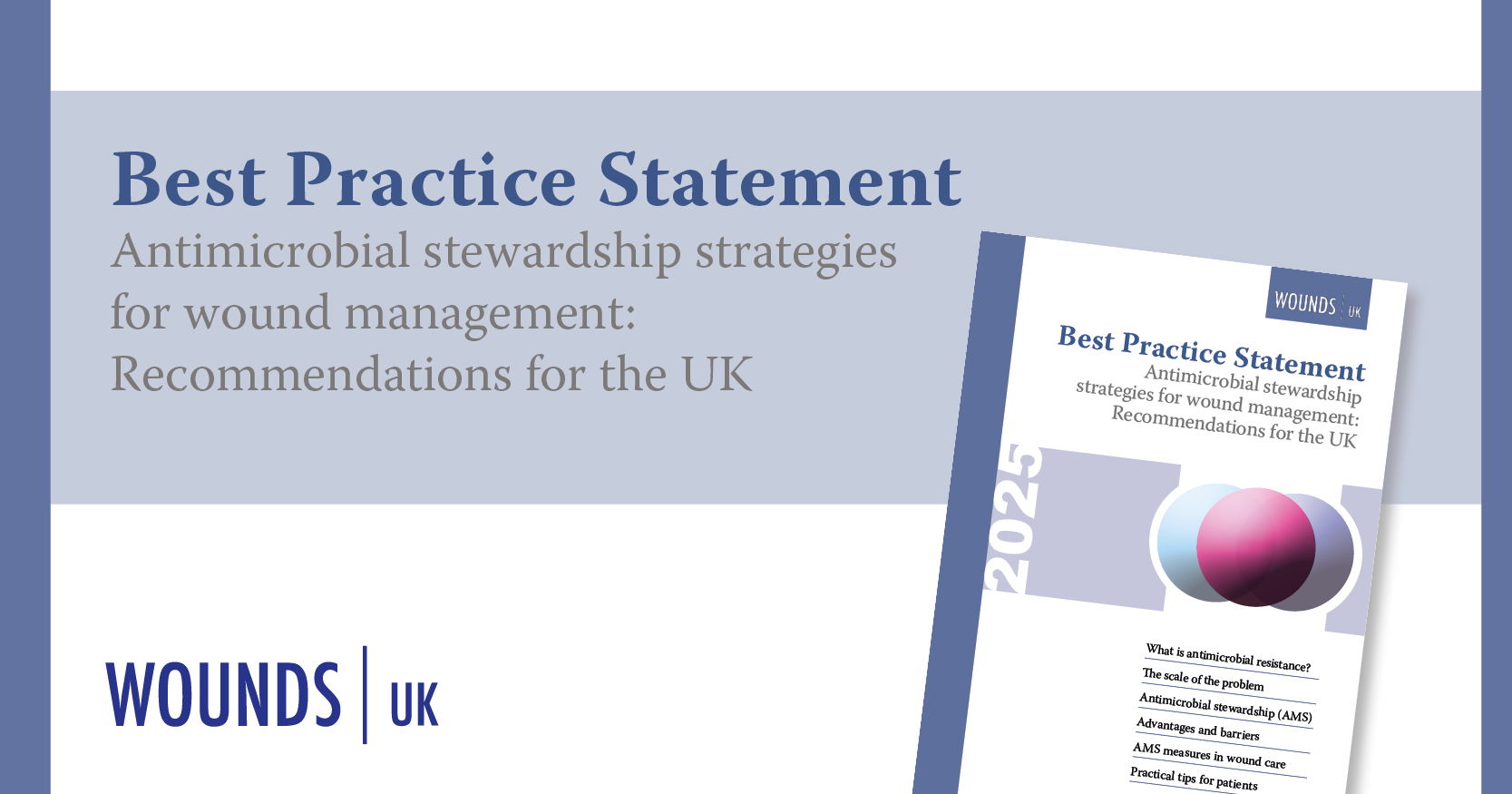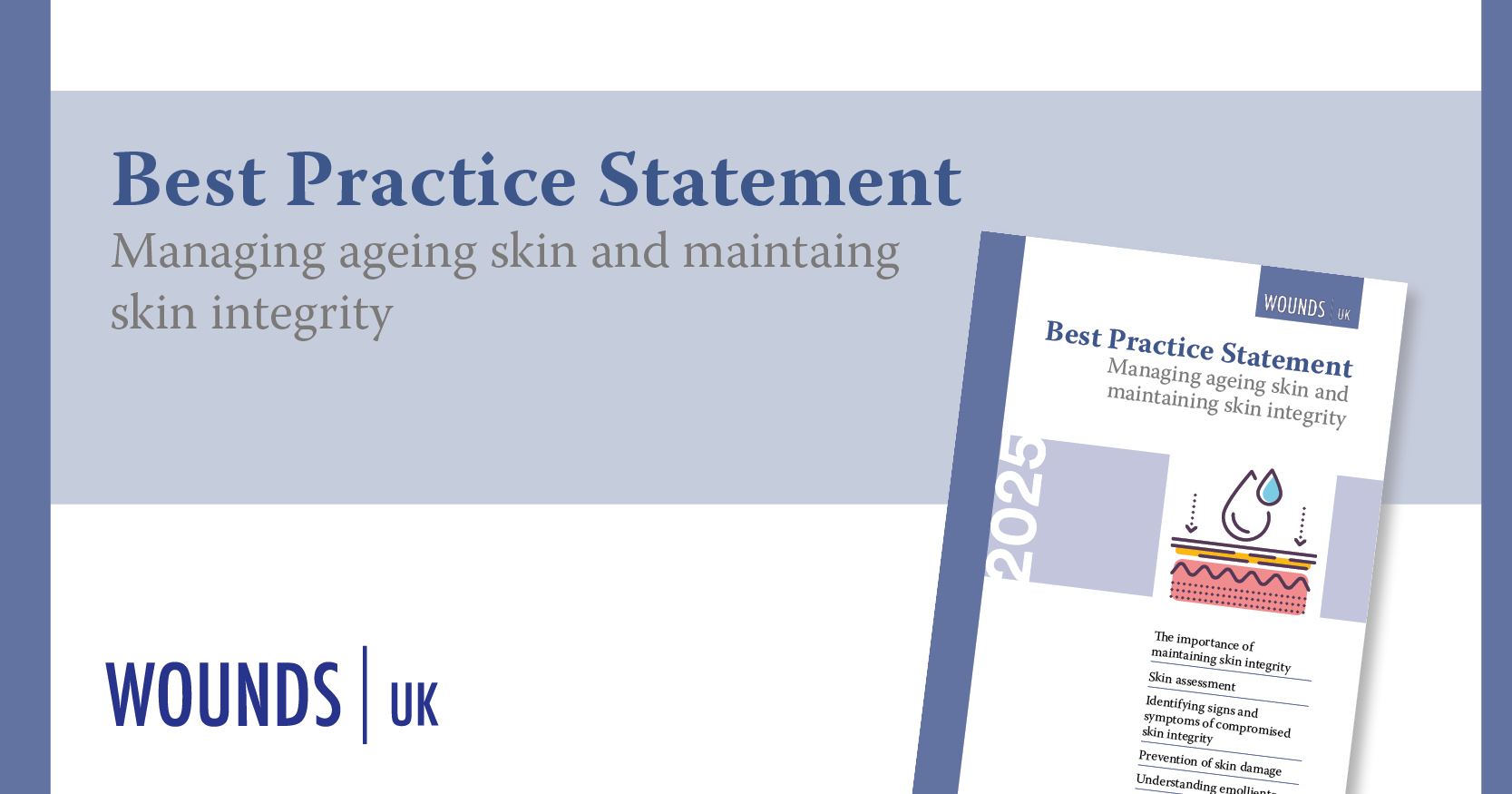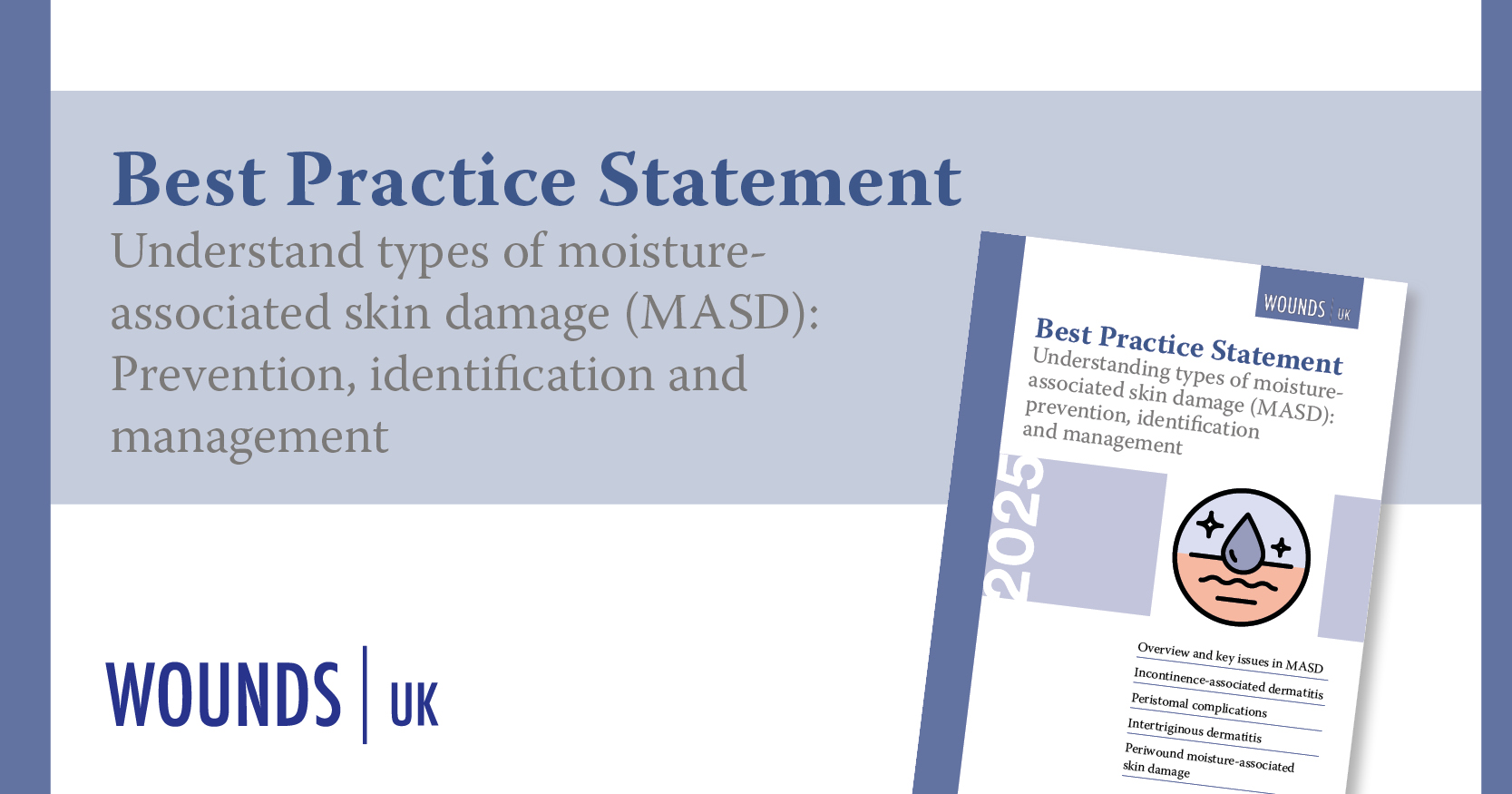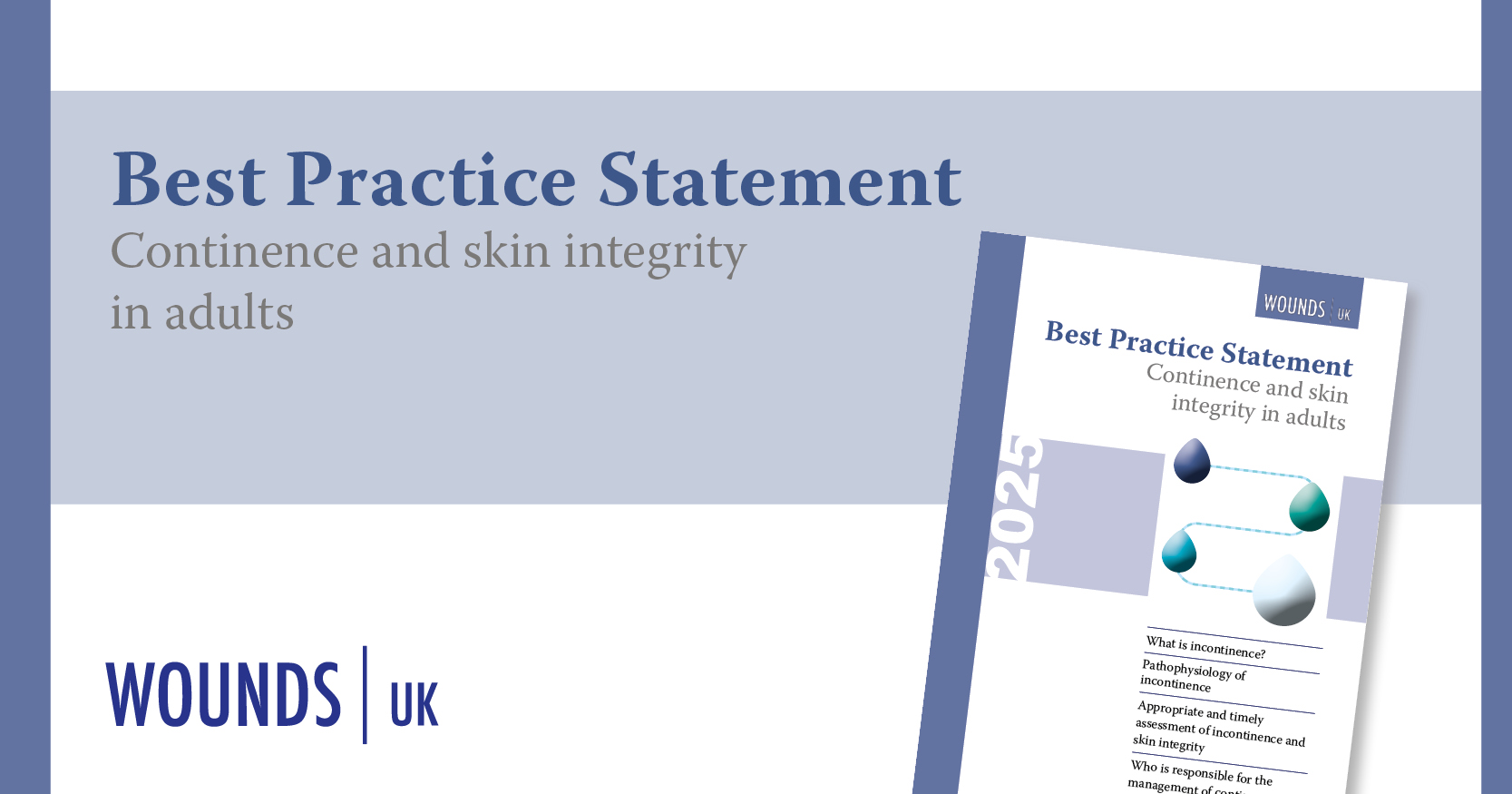ReferencesAdderley U (2020) National Wound Care Strategy Programme: looking at the impact of COVID-19. Wounds UK 16(2): 11
Anderson I (2012) Encouraging compliance and concordance in leg ulcer patients. Wounds UK 8(1): S6-8
Atkin L, Tickle J (2016) A new pathway for lower limb ulceration. Wounds UK 12(2): 32-6
Atkin L, Tickle J (2018) Best practice statement leg ulceration pathway: revision required to reflect new evidence. Wounds UK 14(4): 58-62
Barker I, Steventon A, Williamson R et al (2018) Self-management capability in patients with long-term conditions is associated with reduced healthcare utilisation across a whole health economy: cross-sectional analysis of electronic health records. BMJ Qual Saf 27: 989-99
Blackburn J, Ousey K, Parfitt G (2021) Exploring concepts and current evidence of shared and self-care in the management of lower limb wounds. Wounds UK 17(4): 36-44
British Medical Association (2019) Self care: question & answer. Available at: https://www.bma.org.uk/media/1936/bma-plg-selfcare-nov-19.pdf (accessed 14 December 2022)
Carfora L, Foley CM, Hagi-Diakou P et al (2022) Patients’ experiences and perspectives of patient-reported outcome measures in clinical care: A systematic review and qualitative meta-synthesis. PLoS One 17(4): e0267030
Carr AJ, Higginson IJ (2001) Are quality of life measures patient centred? BMJ 322(7298): 1357-60
Darawsheh W, Chard G (2015) Towards culturally competent professional practice: exploring the concepts of independence and interdependence. Research, Policy and Planning 31(1): 3-17
Diabetes UK (2009) Improving supported self-management for people with diabetes. Available at: https://www.diabetes.org.uk/resources-s3/2017-09/Supported_self-management.pdf (accessed 21 November 2022)
Dowsett C (2021) Transforming venous leg ulcer management: opportunities for self-care solutions. Wounds UK 17(1): 49-55
Elwyn G, Frosch D, Thomson R et al (2012) Shared decision making: a model for clinical practice. J Gen Intern Med 27(10): 1361-7
Fletcher J, Atkin L, Murphy N, Murray S, Ousey K, Sandoz H (2021) Lessons learned from COVID-19: Building a ‘new normal’ in tissue viability. Wounds UK 17(4): 99-103
Gao J, Arden M, Hoo ZH et al (2019) Understanding patient activation and adherence to nebuliser treatment in adults with cystic fibrosis: responses to the UK version of PAM-13 and a think aloud study. BMC Health Serv Res 19(420): 1-12
Goh LJ, Zhu X (2018) Exploring patient and caregiver perceptions of primary healthcare sector home care for simple acute wounds. Adv Skin Wound Care 31(8): 348-60
Gray TA, Rhodes S, Atkinson RA et al (2018) Opportunities for better value wound care: a multiservice, cross-sectional survey of complex wounds and their care in a UK community population. BMJ Open 8: e019440
Guest JF, Ayoub N, McIlwraith T (2015) Health economic burden that wounds impose on the National Health Service in the UK. BMJ Open 5(12): e009283
Guest JF, Fuller GW, Vowden P (2020) Cohort study evaluating the burden of wounds to the UK’s National Health Service in 2017/2018: update from 2012/2013. BMJ Open 10(12): e045253
Gwilym BL, Mazumdar E, Naik G et al (2022) Initial reduction in ulcer size as a prognostic indicator for complete wound healing: A systematic review of diabetic foot and venous leg ulcers. Adv Wound Care (New Rochelle)
Hallas-Hoyes L, Williamson S, Kerr A, Andrews T, Calladine L (2021) An advanced self-care delivery model for leg ulcer management: a service evaluation. Journal of Wound Care 30(9); 751-62
Harding K et al (2015) Simplifying venous leg ulcer management. Consensus recommendations. Wounds International
Health Education England (2022) Module: T- GROW. Available at: https://kss.hee.nhs.uk/wp-content/uploads/sites/15/2022/08/Coaching-for-success-TGROW.pdf (accessed 21 November 2022)
House of Lords (2017) NHS: Wound Care. Available at: https://hansard.parliament.uk/lords/2017-11-22/debates/6C57E65A-A04D-449B-82E9-C836F088A696/NHSWoundCare (accessed 21 November 2022)
Hughes M, Balduyck B (2022) Made Easy: Challenges of venous leg ulcer management. Wounds International
International Self-Care Foundation (2022) What is Self-Care? Available at: https://isfglobal.org/what-is-self-care/ (accessed 21 November 2022)
International Wound Infection Institute (2022) Wound Infection in Clinical Practice. Wounds International
Janamian T, Greco M, Cosgriff D, Baker L, Dawda P (2022) Activating people to partner in health and self-care: use of the Patient Activation Measure. Med J Aust 216(Suppl 10): S5-S8
Jonkman NH, Westland H, Groenwold RH et al (2016) Do self-management interventions work in patients with heart failure? An individual patient data meta-analysis. Circulation 133(12): 1189-98
Kapp S, Santamaria N (2017) How and why patients self-treat chronic wounds. Int Wound J 14: 1269-75
Kapp S, Santamaria N (2020) The effect of self-treatment of wounds on quality of life: a qualitative study. J Wound Care 29(5): 260-68
L&R Medical UK (2022) Club Squeeze In. Available at: https://lrselfcare.co.uk/club-squeeze-in (accessed 21 November 2022
Lindsay E (2017) Leg clubs: A cost-effective social prescribing approach to lower limb management. Wounds Central 1(2): 111-2
Lindsay E (2018) Monitoring service quality: Lindsay Leg Club member satisfaction survey. Br J Community Nurs 23(Sup12): S24-S8
Martínez N, Connelly CD, Pérez A, Calero P (2021) Self-care: A concept analysis. Int J Nurs Sci 8(4): 418-25
Mills J, Wand T, Fraser JA (2018) Exploring the meaning and practice of self-care among palliative care nurses and doctors: a qualitative study. BMC Palliat Care 17(1): 63
Moore Z (2016) Patient empowerment in wound management. Wounds Essentials 11(1): 32-5
Moore Z, Coggins T (2021) Clinician attitudes to shared-care and perceptions on the current extend of patient engagement in wound care: Results of a clinician survey. Wounds International 12(1): 48-53
National Wound Care Strategy Programme (2020) Recommendations for Lower Limb Ulcers. Available at: https://www.nationalwoundcarestrategy.net/wp-content/uploads/2021/04/Lower-Limb-Recommendations-WEB-25Feb21.pdf (accessed 21 November 2022)
Nelson EA, Bell-Syer SE (2014) Compression for preventing recurrence of venous ulcers. Cochrane Database Syst Rev (9): CD002303
NHS England (2014) Five Year Forward View. Available at: https://www.england.nhs.uk/wp-content/uploads/2014/10/5yfv-web.pdf (accessed 21 November 2022)
NHS England (2015) Compassion in care campaign hits new milestone. Available at: https://www.england.nhs.uk/2015/02/hellomynameis/ (accessed 24 November 2022)
NHS England (2017) Next steps on the NHS Five Year Forward View. Available at: https://www.england.nhs.uk/wp-content/uploads/2017/03/NEXT-STEPS-ON-THE-NHS-FIVE-YEAR-FORWARD-VIEW.pdf (accessed 21 November 2022)
NHS England (2018a) Module 1: Patient Activation Measure – implementation quick guide. Available at: https://www.england.nhs.uk/wp-content/uploads/2018/04/patient-activation-measure-quick-guide.pdf (accessed 21 November 2022)
NHS England (2018b) Language Matters. Available at: https://www.england.nhs.uk/wp-content/uploads/2018/06/language-matters.pdf (accessed 21 November 2022)
NHS England (2019) The NHS Long Term Plan. Available at: https://www.longtermplan.nhs.uk/wp-content/uploads/2019/08/nhs-long-term-plan-version-1.2.pdf (accessed 21 November 2022)
NHS England (2020a) Supported self-management: Summary guide. Available at: https://www.england.nhs.uk/wp-content/uploads/2020/03/supported-self-management-summary-guide.pdf (accessed 21 November 2022)
NHS England (2020b) COVID-19: Diabetes online self-management courses. Available at: https://www.england.nhs.uk/coronavirus/documents/covid-19-diabetes-online-self-management-courses/ (accessed 21 November 2022)
NHS England (2020c) Health coaching implementation and quality: Summary guide. Available at: https://www.england.nhs.uk/wp-content/uploads/2020/03/health-coaching-implementation-and-quality-summary-guide.pdf (accessed 21 November 2022)
NHS England (2022a) Care and support you can get for free. Available at: https://www.nhs.uk/conditions/social-care-and-support-guide/care-services-equipment-and-care-homes/care-and-support-you-can-get-for-free/ (accessed 21 November 2022)
NHS England (2022b) Social prescribing. Available at: https://www.england.nhs.uk/personalisedcare/social-prescribing/ (accessed 21 November 2022)
NHS England (2022c) Health and wellbeing coaches. Available at: https://www.england.nhs.uk/personalisedcare/supported-self-management/health-and-wellbeing-coaches/ (accessed 21 November 2022)
O’Meara SO, Cullum N, Nelson AE, Dumville JC (2012) Compression for venous leg ulcers. Cochrane Database Syst Rev 11(11): CD000265
Office for Health improvements & Disparities (2022) Social prescribing: applying All Our Health. Available at: https://www.gov.uk/government/publications/social-prescribing-applying-all-our-health/social-prescribing-applying-all-our-health (accessed 21 November 2022)
Ousey K, Atkin L, Conway B et al (2021) Compression therapy for pharmacy teams. Wounds UK
Queen and Harding (2022) COVID-19 consequences in the management of persons with wounds. Int Wound J 19: 237-8
Proprietary Association of Great Britain (2016) Self Care Nation. Available at: https://www.pagb.co.uk/content/uploads/2016/11/PAGB-SELF-CARE-NATION-REPORT-NOVEMBER-2016-1.pdf (accessed 15 December 2022)
Rae B (2021) Obedience to collaboration: compliance, adherence and concordance. Journal of Prescribing Practice 3(6): 235-40
Riegel B, Westland H, Iovino P et al (2021) Characteristics of self-care interventions for patients with a chronic condition: A scoping review. Int J Nurs Stud 116: 103713
Roberts NJ, Kidd L, Dougall N et al (2016) Measuring patient activation: the utility of the patient activation measure within a UK context—results from four exemplar studies and potential future applications. Patient Educ Couns 99: 1739-46
Sandy-Hodgetts K et al (2020) International best practice recommendations for the early Identification and prevention of surgical wound complications. Wounds International
Schultz G, Sibbald G, Falanga V et al (2003) Wound bed preparation: a systematic approach to wound management. Wound Repair Regen 11: 1–28
Self Care Forum (2013) How to implement a self-care aware approach to demand management. Available at: https://www.selfcareforum.org/wp-content/uploads/2013/10/How-To-Guide-PDF-FINAL.pdf (accessed 21 November 2022)
Self Care Forum (2022) What do we mean by self care and why is it good for people? Available at: https://www.selfcareforum.org/about-us/what-do-we-mean-by-self-care-and-why-is-good-for-people/ (accessed 4 November 2022)
Sheridan NF, Kenealy TW, Kidd JD et al (2015) Patients’ engagement in primary care: powerlessness and compounding jeopardy. A qualitative study. Health Expect 18(1): 32-43
Simmons LA, Wolever RQ (2013) Integrative health coaching and motivational interviewing: Synergistic approaches to behavior change in healthcare. Glob Adv Health Med 2(4): 28-35
The King’s Fund (2017) What is social prescribing? Available at: https://www.kingsfund.org.uk/publications/social-prescribing (accessed 21 November 2022)
Vowden P and Vowden K (2016) The economic impact of hard-to-heal wounds: promoting practice change to address passivity in wound management. Wounds International 7(2): 10-15
West Suffolk Clinical Commissioning Group (2020) Self-care during COVID-19: Guidance for patients looking after their wound at home. Available at: https://www.westsuffolkccg.nhs.uk/wp-content/uploads/2020/06/Self-care-for-Wounds-Guidance-WSCCG.pdf (accessed 21 November 2022)
Whitmore J (2004) Coaching for Performance: Growing People, Performance, and Purpose. Nicholas Brealey Publishing, London
White R, Witts S, Hopkins A, Ewart J (2016) The differences in approach and clinical outcomes of venous leg ulcers managed in primary and secondary care. Wounds UK 12(2): 10-19
Wilde K (2020) Patients’ perceptions of self-management of chronic wounds. Wounds International 16(3): 38-44
World Health Organization (2016) Patient Engagement: Technical Series on Safer Primary Care. Available at: https://apps.who.int/iris/bitstream/handle/10665/252269/9789241511629-eng.pdf (accessed 4 November 2022)
World Union of Wound Healing Societies (2020) Optimising wound care through patient engagement. Wounds International
Wounds International (2016) International Best Practice Statement: Optimising patient involvement in wound management. Wounds International
Wounds UK (2016) Best Practice Statement: Holistic management of venous leg ulceration. Wounds UK
Wounds UK (2018) Best Practice Statement: Improving holistic assessment of chronic wounds. Wounds UK
Wounds UK (2019) Best Practice Statement: Addressing complexities in the management of venous leg ulcers. Wounds UK
Wounds UK (2021a) Best Practice Statement: Compression hosiery: A patient-centric approach (3rd edn). Wounds UK
Wounds UK (2021b) Best Practice Statement: Addressing skin tone bias in wound care: assessing signs and symptoms in people with dark skin tones. Wounds UK
Wounds UK (2022) Best Practice Statement: Holistic management of venous leg ulceration (second edition). Wounds UK

